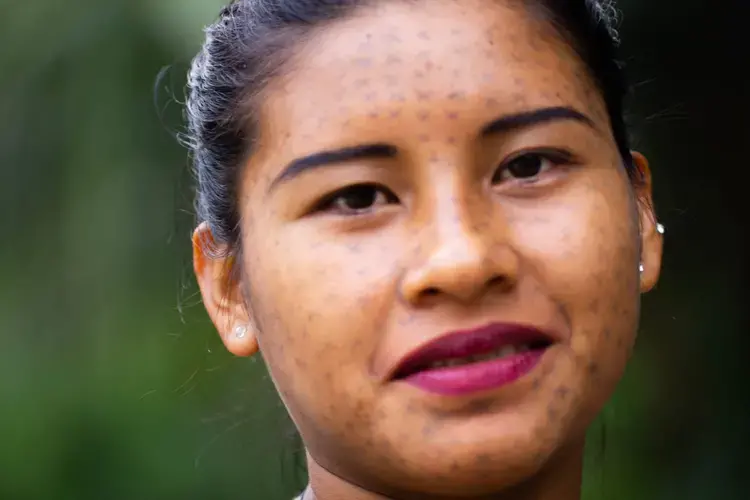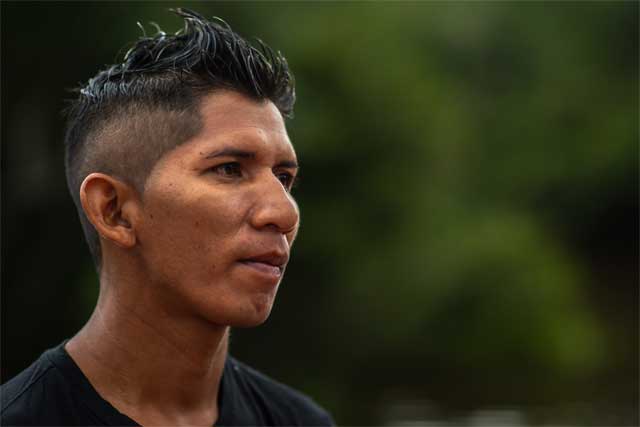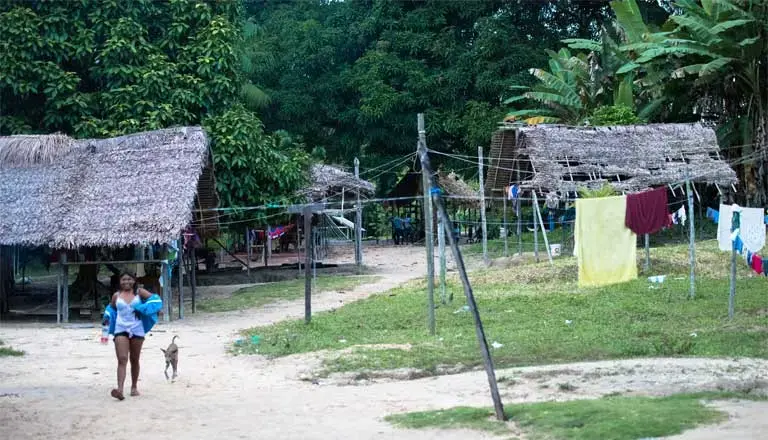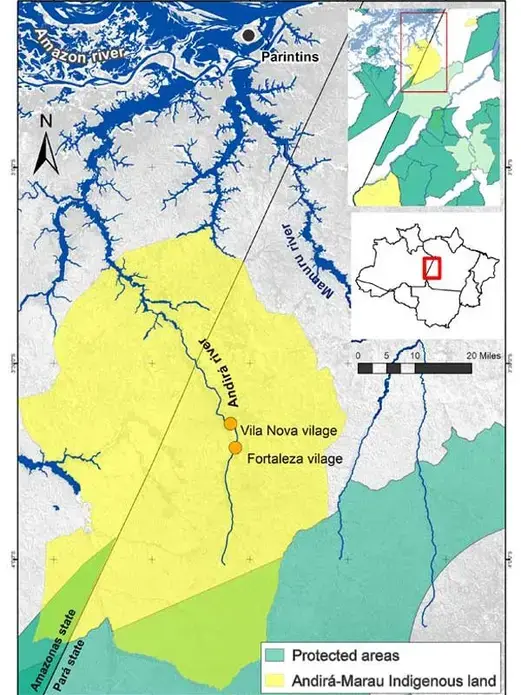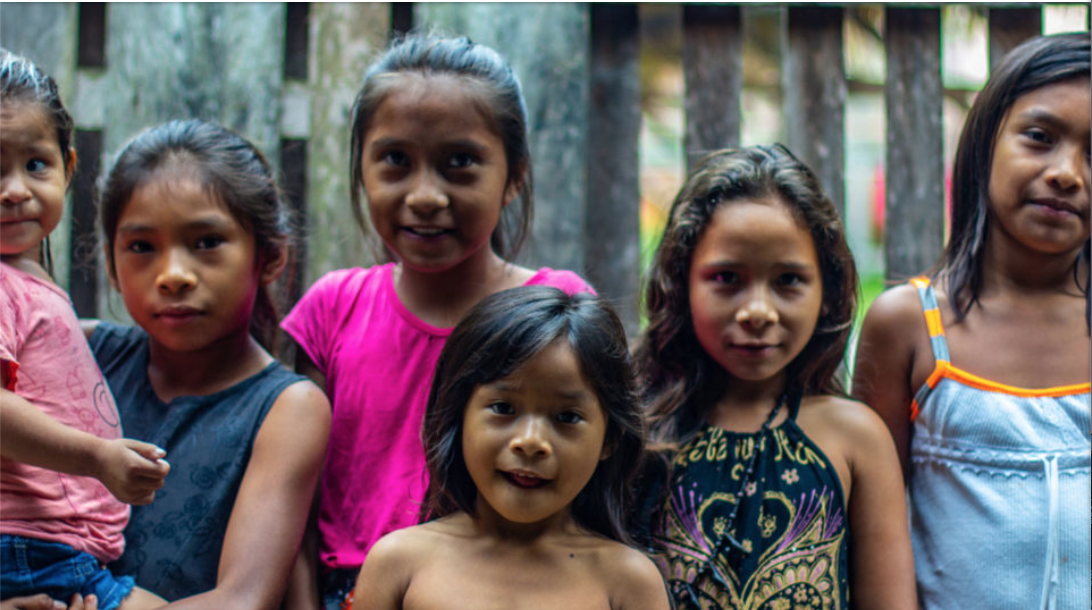
- Parintins, site of Brazil’s big annual indigenous festival, is typical of towns in the Brazilian Amazon. The Sateré, and other indigenous groups living or working there, often endure discrimination and work analogous to slavery. Civil rights are few and indigenous populations inhabit the bottom rung of the economic ladder.
- Now more than ever, indigenous groups fear the loss of their cultural heritage and land rights as guaranteed under the 1988 Brazilian Constitution. New president Jair Bolsonaro wants to achieve indigenous societal “assimilation,” a process by which an ethnic minority group’s traditional way of life and livelihoods is erased.
- The strongest advocates of indigenous assimilation are the ruralistas, rural wealthy elites and agribusiness producers, who have the most to gain via access to the timber, land and mineral wealth found within indigenous territories. The bancada ruralista agribusiness lobby is strong in Congress, and it supports Bolsonaro.
- The Sateré, along with other indigenous groups, have endured a long history marked by extermination and exploitation. Brazil’s 900,000 indigenous people are increasingly joining together to fight the anti-indigenous policies proposed by the Bolsonaro administration and supported by the ruralists.
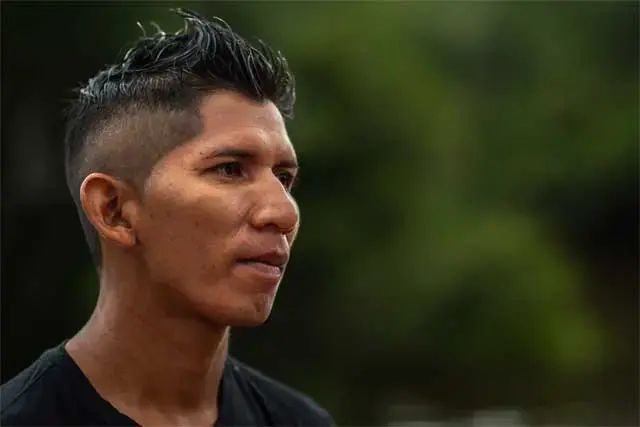
In February, a Mongabay reporting team travelled to the Brazilian Amazon, spending time with the remote Sateré-Mawé, documenting their culture and long-time conflict with mining companies and land grabbers. This series looks at new threats imposed on the Sateré and indigenous groups across Brazil as they’re threatened by the ruralist-friendly policies of President Jair Bolsonaro. The trip was funded by the Amazon Rainforest Journalism Fund in association with the Pulitzer Center and Mongabay.
PARINTINS, BRAZIL – On the banks of the Amazon River, in the Parintins municipal district of Amazonas state, Benito Miquiles, a young Sateré indigenous man watches boats come and go. Francesa, the port where he stands, is located in a small bay where the district’s untreated sewage flows into the river. It’s also here that boats travelling to and from the state’s interior stop to unload, with Indians and fisherfolk hefting heavy bags of manioc flour, copaíba oil and guarana, then forced to walk down a narrow 15-foot-long plank and on into town to sell their wares.
Benito, who accompanied and guided the Mongabay reporting team throughout its trip, knows better than most the happenings, sounds and smells of Francesa. He lived here, out in the open, slinging his hammock among the boats, for two years while studying for a college degree in Parintins. Now age 25, he recently earned a diploma in intercultural indigenous studies from the Federal University of Amazonas.
“It was a big achievement,” the young Sateré-Mawé acknowledges.
Benito is proud to be Sateré, but people in Parintins frequently comment that he doesn’t look like a “real Indian.” His hair is stylishly coiffed, he owns a smart phone, takes “selfies” and wears a cap and sunglasses, but for Benito indigenous identity is something that comes from inside himself, irrespective of what he is wearing: “I was born Sateré, I grew up Sateré, and wherever I go I am Sateré. I can use a coat and tie, trainers, smart clothes, but I will always be Sateré.”
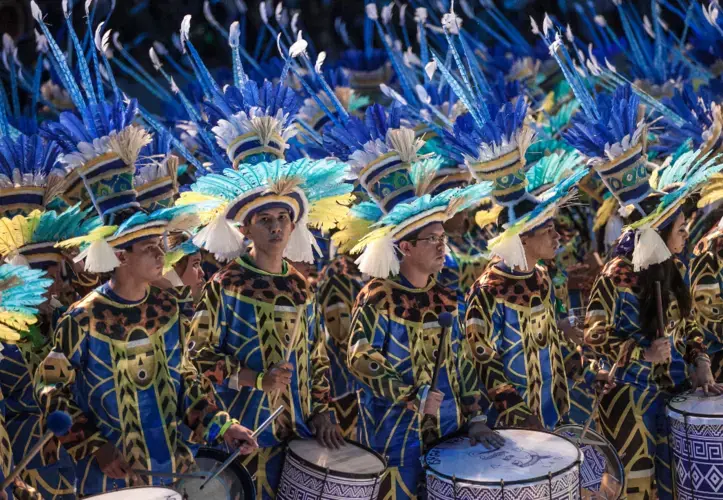
As some profit by indigenous culture, racism is rife
A few miles away, at a far better equipped port, hundreds of foreign tourists disembark from luxury cruisers several times weekly to get a taste of Amazon culture. While they come throughout the year, they’re most numerous in June, when the Amazon’s biggest most important cultural event, the Folkloric Festival of Parintins, is held. Dubbed the “greatest expression of Amazon culture,” it attracted almost 100,000 tourists last year, nearly doubling the municipality’s population for a brief time. On a national scale, only Carnival is more prominent for the region and Brazil.
The Festival presents an idealized and exotic image of the Amazon’s indigenous people, complete with tuxauas (as Sateré political leaders are known), pajés (spiritual leaders), and cunhã-poranga (the prettiest indigenous women).
Most of the festival’s women dancers are clad in straw skirts and headdresses made from parrot feathers; they also sport body painted designs created with ink extracted from genipapo berries.
The Festival is based on Amazonian folklore and indigenous cosmologies, with two teams, called Boi Caprichoso and Boi Garantido, acting out with hundreds of musicians and dancers, the moment in which a ranch employee and husband kills a bull to satisfy the wish of his pregnant wife. The ranch owner first calls in doctors, who cannot bring the bull back to life, and then a pajé who successfully resuscitates the dead animal. Each year one of the teams is declared the winner for better presenting the legend. There is fierce rivalry in Parintins between the supporters of the two rival teams, with supporters of Boi Caprichoso dressed in blue, and those of Boi Garantido dressed in red.
The city doesn’t only host the annual festival, but also serves up its indigenous image year-round. “Indigenous” handicrafts sell at a local pavilion, though not all are as authentic as vendors would have customers believe. One, when questioned, admitted his “indigenous” headdresses were made from red-and-blue painted chicken feathers shipped in from São Paulo.
Ironically, this town, which so proudly displays and profits from its indigenous connections and heritage, also seems to have considerable difficulty accepting and respecting real Indians. Many Parintins residents seem to resent the indigenous presence, and we’re told Indians face frequent racism. Something we witnessed first-hand.
Benito suffered a racist slight at the boarding house at which the Mongabay team stayed. As he entered the lodging, the woman who ran it, a big supporter of Boi Caprichoso, commented: “It won’t take long, with all this coming-and-going of ethnic people, for something to go missing.” A few minutes later, she claimed to have seen Benito scratch her car, though there was no sign of damage on the vehicle.
In Francesa port, we witnessed a second slight. While our team waited for a food stall vendor to prepare our hot barbecued chicken on wooden skewers, he curtly directed Benito to take a cold one.
These discriminatory incidents happened everywhere – in taxis, restaurants and shops. Indigenous people endure these daily prejudices, but find them to be very painful. “Racism gnaws at you inside,” Benito explained.
This callous treatment, Benito said, is what the Sateré and other indigenous groups have come to expect in Amazonian towns – where they’re often discriminated against and employed as quasi-slave labor. Almost all the young women studying at the college with him in Parintins, he told us, were working as maids. Many didn’t receive any cash payment, but rather exchanged their hard work only for free accommodations and food.
The sociologist Wagner Araújo, who has studied domestic service among the Sateré, says that, given the lack of public policies protecting indigenous civil rights, the only place for most within urban society is as vulnerable and exploited populations on the bottom rung of the economic ladder.
Indigenous autonomy vs. assimilation
Benito has no intention of staying in Parintins. Now that he has a diploma, he will go back to his rural community and campaign to get a school opened there – a school that will integrate Sateré culture and tradition into the curriculum.
However, he is traveling in the opposite existential direction from that proclaimed for indigenous people by Brazil’s new president, Jair Bolsonaro. On his second day in office last January, Bolsonaro tweeted that Indians don’t live “in the real Brazil,” adding: “We’re going to integrate these citizens and give them value as real Brazilians.”
The Bolsonaro administration hasn’t consulted indigenous people concerning their personal desires regarding integration. Samuel Batista Filho, a Sateré, contradicts the president. Here in our community, he said, “it’s only the government that wants that.”
The policy Bolsonaro intends to employ to achieve indigenous societal integration is called “assimilation,” a process by which members of an ethnic minority group are denied the cultural characteristics that distinguish them from a nation’s dominant cultural group. Sociologists have another term for the policy: ethnocide, the systematic conscious destruction of a minority people’s traditional way of life and livelihoods.
Until the late 20th century, assimilation was the Brazilian government’s official indigenous policy. In 1976, Maurício Rangel Reis, Interior Minister during the military dictatorship of General Ernesto Geisel, announced that he planned to reduce the number of indigenous people from 220,000 to 20,000 in just ten years. The main tool in this process was to be assimilation. During the dictatorship, Indians were sometimes driven out of their communities and flown by plane to distant locations where they were dropped off; meanwhile, outsiders seized their land. In some cases, assimilation became extermination.
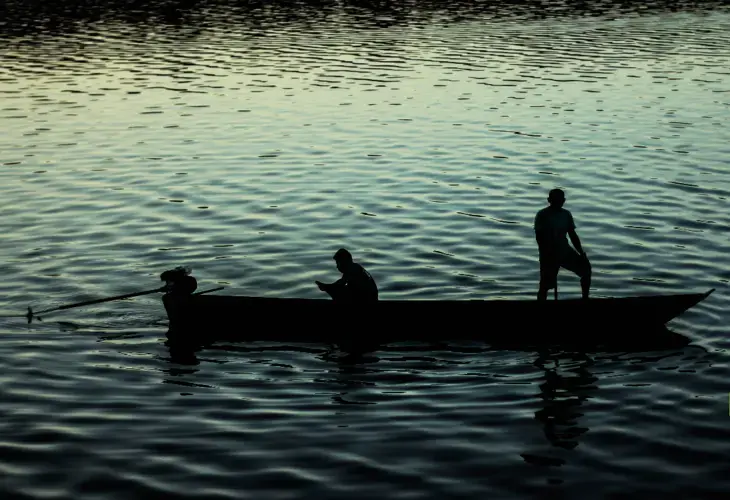
Government by and for the people
Then, in a flurry of progressive reform following the return to civilian rule, came the passage of the 1988 Constitution – a watershed moment, giving Indians the right to be Indians forever, according to Carlos Frederico Marés, an authority on indigenous rights and former president of the indigenous agency, FUNAI.
The Constitution, he says, abolished the “provisional nature” of indigenous rights. From that point onward, federal legislation stopped regarding indigenous people as “backward,” or as “doomed to extinction,” and importantly, determined that Indians should have “the permanent and exclusive right” to their lands – a legal declaration that led to the founding of hundreds of indigenous territories. Unfortunately for all, it also led to decades of conflict as the government dragged its feet on indigenous reserve demarcation, and as rural elites fought to prevent territories from becoming official.
Still, the 1988 Constitution has proven to be a major boon for beleaguered indigenous populations. Far from heading towards extinction, indigenous numbers rebounded, standing today at around 900,000 people, mostly concentrated in the Amazon. Many continue to preserve their cultures and traditions despite pressure to do otherwise.
Attitudes in Brazil are also changing. Recent polls show that the public feels far more favorably toward indigenous groups than in the past, with six out of ten Brazilians currently opposed to any reduction in the amount of land in indigenous hands.
However, many Brazilians living in Amazon towns, like Parintins, have not altered the ways in which they regard and treat Indians. Like Bolsonaro, a self-professed fan of the military dictatorship and its actions, they continue seeing indigenous people as “inferior” and believe they should be assimilated, or sometimes worse.
Luana Ruiz and the anti-indigenous agenda
The strongest advocates of indigenous cultural annihilation are the ruralistas, rural wealthy elites and agribusiness producers, who have the most to gain via access to the timber, land and mineral wealth found within indigenous territories. The bancada ruralista agribusiness lobby is extremely strong in Congress, and it was staunch ruralist support that helped catapult Bolsonaro into office.
Ruralists, along with the president, argue that indigenous peoples control “an enormous amount of land,” utterly disproportionate to their number. Many of those who are hostile to indigenous rights occupy key positions in Bolsonaro’s government. One of the most outspoken advocates of assimilation is Luana Ruiz, a lawyer now serving as Assistant Secretary for Land Affairs in the Agriculture Ministry.
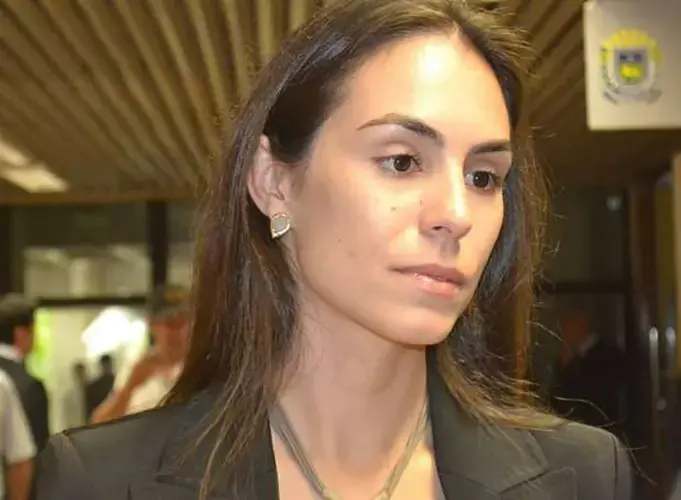
Ruiz is poised to play a leading role in the key task of demarcating indigenous reserves, but no one expects fairness from her process. She is famously vehement in her anti-indigenous views, and outspoken in her statements: “We need to cut the legs off [the indigenous agency] FUNAI” she has said. “We mustn’t talk about indigenous peoples – there are only people, the Brazilian people.… We mustn’t talk about indigenous territory – there is only one territory, the Brazilian territory.” Ruiz has even recommended arms use against retomadas (reoccupations) by Indians of ancestral land.
The Ruiz family seems likely to benefit heavily from this anti-indigenous agenda. The family claims a large property that is superimposed on the Indigenous Territory of Nhanderú Marangatú, which is claimed by the Guarani Kaiowá indigenous group in Mato Grosso do Sul. The process setting up this indigenous territory was completed in 2005, but its demarcation was partially reversed by ruralists who went to court to block it – contributing to a local climate of conflict and violence.
The Catholic Church’s Missionary Indigenous Council, CIMI, has formally requested the Office of the Attorney General of the Republic investigate a claim of possible conflict of interest against Ruiz. The Agriculture Ministry told Mongabay that it has provided information to the Presidency’s Ethics Commission about the questions raised concerning Ruiz.
Leading indigenous experts believe that all the recent talk of assimilation, and of Brazil being a single nation, absent of cultural differences, is a thinly veiled attempt to take Brazil back to the earlier historical assimilation policies of the military dictatorship, when indigenous groups were threatened with extinction.
According to the anthropologist Daniela Alarcon, the discourse that merges indigenous groups with “all Brazilians” is a way of exterminating them as peoples with specific, collective rights. Alarcon explains that, throughout history, the state has not always opted for direct physical violence, but at times has put in practice measures to wipe out the identity of indigenous peoples. She says: “The state has employed a wide range of strategies to infringe the rights of these groups, involving administrative, legislative and judicial measures, as well as the production and circulation of discourses that project a negative image of the Indian.”
According to lawyer Pedro Martins, who works with the human rights NGO, Terra dos Direitos, the Bolsonaro government is already imposing assimilation in many different ways. He says that “the loss of scholarships for indigenous youngsters to go to university, and the proposals that agribusiness and mining companies should be allowed onto indigenous land, are initiatives that oppress indigenous people by making their existence conditional on another, very different way of life.”
A history of degradation
The Sateré-Mawé are well aware of the dangers they face. Today, they number almost 13,000 and live in about 100 villages in the 780,000-hectare (3,011-square mile) Indigenous Territory of Andirá-Marau. They only got the right to their ancestral land officially recognized in 1986, after a damaging conflict with mining companies. Their struggle was recorded in a report published in 2014 by the National Truth Commission, set up by the Brazilian government to investigate human rights violations occurring between 1946 and 1988.
The report relates how, in 1980, the state-owned oil company, Petrobrás, opened 300 kilometers (186 miles) of rough roads into the local rainforest, clearing trees so that helicopters could set down on indigenous land. Then the French company, Elf-Aquitaine, moved in. It only withdrew after an Indian was killed.
“At that time nobody here spoke Portuguese. We were frightened. They stayed for several years then left,” the tuxaua (leader) Donato Lopes told Amazônia Real.
Benito Miquiles, who was born in 1993 a decade after the oil companies left, says his father still talks about the harm done to the environment then: “My father says that there was an abundance [of wildlife] in the region, but when the companies came and carried out explosions with dynamite, a lot of fish, caiman, alligators and turtles died. It became more difficult to hunt in the forest.”
It was the scale of indigenous resistance that convinced the government eventually that the Indians needed a proper indigenous reserve, a process finalized in 1986.
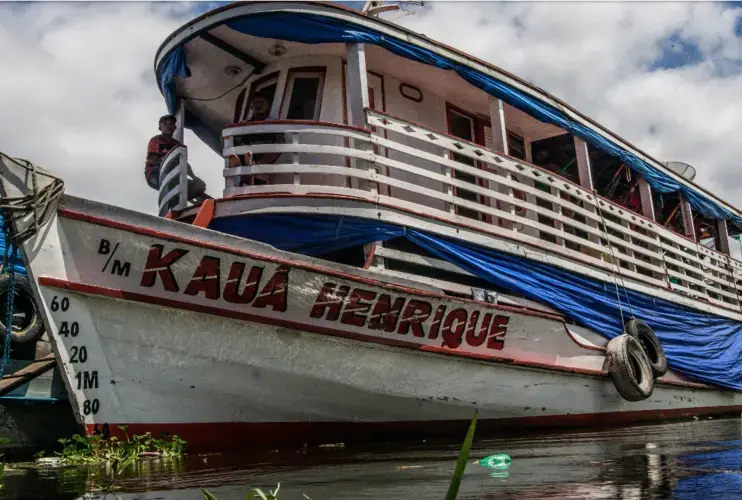
Wary of a Bolsonaro future
This troubling history has caused tremendous concern among the Sateré about the Bolsonaro administration, especially since they learned of government plans to permit mining on indigenous lands, made known via a March announcement by new Minister of Mines and Energy Admiral Bento Albuquerque speaking at the annual convention of the Prospectors & Developers Association of Canada (PDAC).
Even though the International Labour Organisation’s Convention 169, of which Brazil is a signatory, guarantees such activities only be permitted with the full agreement of impacted indigenous groups, Admiral Albuquerque stated that Brazil’s indigenous people would be given a voice, but not a veto, regarding mining on their lands.
Timel Batista Miquiles, an indigenous leader from the Castanhal community along the Andirá river, said that he will shortly be calling a meeting of tuxauas to discuss a resistance strategy: “We are not going to allow companies to come onto our land again and cause the same havoc that they brought in the past,” he said.
The Ministry of Mines and Energy told Mongabay that it is unwilling to discuss its future steps, as they are currently being formulated. However, analysts say that, when mining plans on indigenous lands are formally announced, it is likely that the ministry will also declare that it will ensure that the projects will not cause socio-environmental damage. Whether any socio-environmental assessments will be conducted is unknown.
The ministry has often made, but not kept, promises to prevent socio-environmental damage in the past. Researchers from the Centre of Mineral Technology (CETEM) within the Ministry of Science, Technology and Innovation studied 102 mining projects in 22 Brazilian states over a three-year period. According to researcher Francisco Rego Chaves Fernandes, the study concluded that mineral extraction has “extremely large impacts in the regions where it is installed. It provokes a whole set of environmental and socioeconomic consequences.” Large scale mining project impacts are particularly damaging in a vulnerable ecological region such as the Amazon rainforest.
It seems clear to analysts that the Bolsonaro administration’s return to a policy of assimilation, and its weakening of indigenous rights and indigenous agencies, will make it far easier for transnational mining companies, land grabbers, illegal loggers and illicit ranchers to move in quickly.
At risk are not only the 780,000 hectares (3,011 square miles) of rainforest within the TI Andirá-Marau Indigenous Reserve, but also the nearly 3 million hectares (11,583 square miles) of forest in protected areas bordering the reserve, along with indigenous lands across Brazil.
The Mongabay team will define the scope of these looming environmental, cultural, and economic threats to the Sateré, along with their response, in upcoming articles in this series.
Support for this reporting was made possible by the Rainforest Journalism Fund, in association with the Pulitzer Center.
